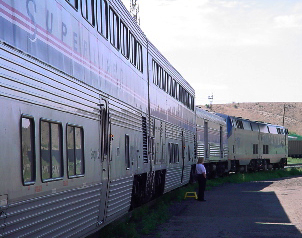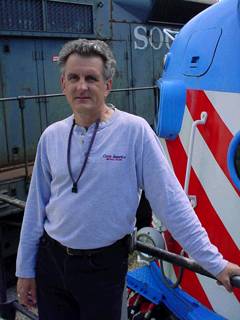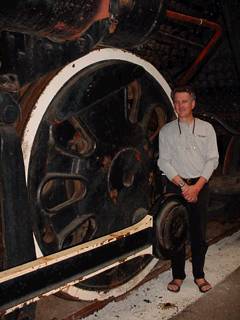(Click any picture which has a 'pointing hand' when the curser is over it (and the photo has a thin blue border), to get a double-sized copy, click BACK, in your browser to return to this page.)
|
|
While at your first meal in the diner, check out the same menu for the other meals you will be having there (above). If you are in a sleeper, someone will come by your room and ask what time you'd like to eat: 6 pm, 6:45, 7:45, etc.
I-80 parallel to the railroad. |
Sierra View |
Reservoir in Yuba Gap. |
|
Boarding at new, temporary station in Reno. |
|
|
The end of July 23, 2004. sunset 8:13 pm. Partly cloudy, mostly clear. |
The beginning of July 24, 2004, Salt Lake City, UT |
July 23, Chris went for supper at 6 since he'd skipped lunch, I had chosen dining time of 7:30, but was not called until 8:30. Note, except for the first call, others seem to be later, so if you do not want to eat late, take the 6 pm, or anything later you can add 45 minutes to an hour to for realistic time of seating. I wasn't really hungry because lunch had been at 3 pm after our SAC to SAC electrical adventure. For lunch I had ordered Burger, chips, slaw, and Sierra Mist with apple pie ala mode. By the time dinner was over, 10 pm, I found I couldn't get to sleep in the upper bunk of our economy room, perhaps too much water at dinner! I had forgotten that I always get a Deluxe room for two reasons: bathroom IN the room, and enough room for a chair besides the two seats during the day and upper and lower berth during the night. This makes two great advantages: room to change clothers in the room and being able to go to the bathroom any time without leaving your room. But, I'm not as dumb as I look: A comp. economy room is better than a deluxe or coach out of one's own pocket!
Finally got to sleep and up at 5:30, showered, and dressed before Salt Lake City Stop (pictures below).
Time for fuel fillup, baggage, new crew, and a stretch for passengers for 30 min. |
|
Michael photographs Shawn in front of 201. |
|
|
|
Where the slide came down. |
|
|
Lower Gullily Loop. |
|
Spanish Fork Creek below the rails |
Highway above. |
Kyuane Tunnel |
Toward Soldier's Summit |
Castle Rock, west of Helper, UT. |
Utah RR station and water tower. |
Utah RR station and water tower. |
Helper, Utah stop for stretch. |
At Helper, UT |

|
|
|
|
|
The sky became more interesting broadening
the view.
|
Old fence posts and old telegraph poles added interest. |
|
|
|
|
On some curves, we could look right up the river. |
|
|
|
I liked the solitary cottonwood tree. |
|
and solitary boatman. |
|
|
Grand Junction
|
old station
|
Grand Junction
|
new station.
|
Inside new station. |
|
Outside new station. |
Detail of Old Station sign |
Chris kept me informed about sights coming up so I took quite a few photos as the light faded for the day. Glenwood Springs and Glenwood Canyon after that were particularly interesting. The Canyon has the very expensive I-70 running through the canyon with Hwy. 6, the RR and the river and a jogging and biking trail. The canyon walls were vertical and there were many scenic shots to take.
"With the exception of a couple of places, the old US-6 readway was eliminated during the construction of I-70," Don Merchant. (Thanks for the information, Don)
Close to Flora Loucheur's Clinton, CO, home. |
Palasades School |
|
Glenwood Springs, stretch break. |
I-70 and access road with bus and rubber boats. |
|
|
Shoshone Dam, named after the Shoshone Indians, in Glenwood Canyon. |
|
|
Thunder head and rainbow and rain below. |
Magazine Cover of Glenwood Canyon. |
|
View from our dining window from 6 to 8 pm... |
|

|
Thanks to freind Bob "Rock Island Line" Williams for early corrections to this report. |

|
I often get requests to e-mail photographs I take to people I meet on trains. It is easier than that to use my photos! TrainWeb allows you to use any of our photos at no cost, just reference them properly. When I tell folks this policy, I see relief in their faces and they say, "I'll quit worrying about taking photos of the rest of the trip and just use yours." It is as easy as that! One exception to the Policy: I DO have higher resolution photos than those we use at TrainWeb and you can e-mail me for copies of specific photos, in my articles (not other TrainWeb reporters). Those photos are $10 per 5 x 7 and $20 for an 8 x 10, but you'll probably find those online, especially the 640 x 480 resolution sufficient. For all the details go to the Photo Use Policy At Trainweb [ http://www.trainweb.com/photos/photohdr.htm ].
--Carl@TrainWeb.com